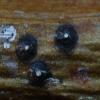
31-05-2013 12:07
Peter ThompsonHello Everyone,I recently found fruit bodies, each

29-05-2013 13:54
Hello,If found these small black things (0,2/0,25

29-05-2013 22:05
 Martin Bemmann
Martin Bemmann
Hi all,before you will vanish to Somiedo (you luck

29-05-2013 21:14
Hello I found a yellow ascobolus on deer dung c

28-05-2013 02:14
Hello to all,I found this ascomycete in cow feces,

28-05-2013 13:53
Jean-Pierre VIDONNEBonjour à tous. Je ne parviens pas à identi
Phacidium-like Fruit Bodies with Valsa-like Spores on Bark of Salix
Peter Thompson,
31-05-2013 12:07
I recently found fruit bodies, each with an individual blackish stroma, peppering the bark of a dead twig of Salix.
The perithecia were flattened and located under the bark rather than in the dead wood.
I have attached images of the microscopy and the fruit bodies. The spores resemble those of valsoid ascomycetes, but the fruit bodies are individually immersed.
I wonder if anyone has encountered these before, and may know their genus and species.
Thank You,
With Best Wishes,
Peter.

